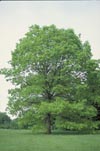Home >
Quercus alba, White Oak
White Oak has a tap root that grows beneath the trunk in soil that drains well, but this is not present on most trees planted on clay or compacted soil. The availability of new nursery production techniques to control root growth should help growers of nursery plants make more of these native trees available. White Oak grows best in moist soil that does not dry out for long periods. Trees tolerate high soil salt - up to 8 mmhos/cm. Trees compartmentalize decay fairly well meaning that once injured, the tree has the ability slow or stop the spread of decay.
Trees are usually well structured and require little structural pruning after about 30 years except to remove dead branches. Early pruning should concentrate on maintaining a central trunk. Branches should be spaced about 18 to 36 inches apart.
Transplant or root prune White Oak regularly when the trees are young in the nursery since the deep-growing tap root in well-drained soil can make transplanting very difficult. White Oak grows in sun or partial shade and prefers an acid, moist, well-drained soil. Water trees faithfully until well established. Chlorosis due to micronutrient-deficiency occurs on high pH soil.
Eastern
North America from Southern Canada and Maine to panhandle Florida except
in the lower Mississippi River valley on a wide range of soils except
very wet or very dry. Adapts well to infertile sites provided they are
not extremely dry. Most abundant on northern and eastern middle and lower
slopes. Seldom above 500 feet elevation in the north but can be found
as a small tree as high as 4500 feet in the southern Appalachians.
Wood weighs about 65 pounds per cubic foot and is considered ring porous. Oaks serve as larvae host plants for the brown duskywing butterfly (Erynnis horatius) and the gray hairstreak (Strymon melinus).
National champion is 96 x 119 feet in Maryland.






